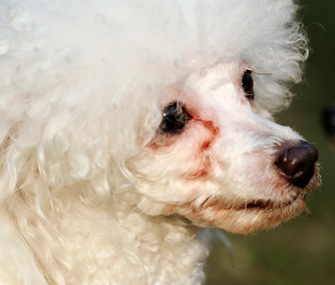Why Does My Dog… Have Stains Under His Eyes?
Published on August 14, 2012

For these and other breeds, the fur of the face holds moisture and fosters the growth of bacteria, which can lead to rust-colored staining, skin irritation and, in some cases, a nasty smell. Because many of these dogs have a white coat, the problem is that much more obvious.
Uncover the Cause
To have a chance at resolving those ugly rust stains, you need to start by seeing your veterinarian. It’s not uncommon for there to be contributing factors that need to be resolved, in addition to the discoloration. Some possibilities include:
- Plugged, diseased or damaged tear ducts
- Eyelashes that turn inward, scraping the surface of the eye
- Eyelids that block the tear flow
- Allergies
You’ll need to work with your veterinarian to resolve any and all of these issues in order to stop the staining. At the least, you will need to keep the area under your dog's eyes clean and keep the fur on his face trimmed short to minimize any habitat for bacteria. If surgery is necessary to correct or repair eyelids, eyelashes or tear ducts, your veterinarian may refer you to a board-certified veterinary ophthalmologist.
What about pet store products that promise a miracle cure? These typically have antibiotics as their active ingredient, and I simply can’t recommend them because of the problems with the development of antibiotic resistance. The casual use of antibiotics is one all health authorities, in both human and veterinary medicine, take very seriously. Don't try to treat this on your own; talk with your vet and establish a plan of action that will really work for your dog.

